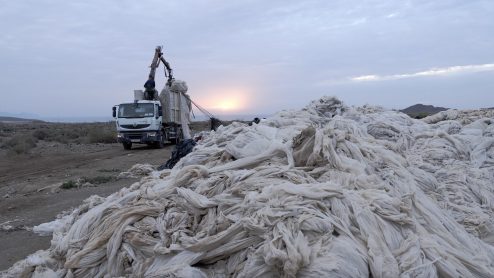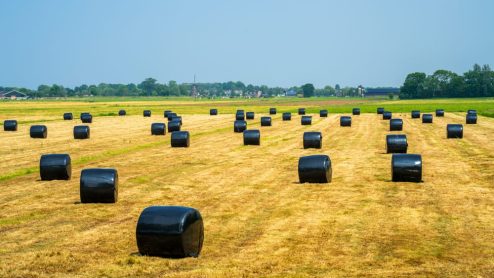UK farmers are still burning toxic plastics on agricultural land despite it being illegal
Mismanagement of agriplastic waste occurs throughout the UK food supply chain – including UK farmers who continue to burn or bury plastics used in food production on their land despite the practices being banned.
It is estimated that UK farms produce 135,500 tonnes of contaminated agricultural plastic waste each year, roughly equivalent in weight to 900 adult blue whales.
But according to the Chartered Institution of Wastes Management, it is estimated that only 20-30 per cent is reprocessed into new products while the rest is disposed of, including illegal burning, burying, dumping or export (which often entails illegal plastic waste exports ultimately being burnt or dumped abroad).
 A new report released today by EIA, Cultivating Plastic Part 3 – Agriplastic waste mismanagement and criminality, highlights that UK farmers are continuing to burn these plastics in-situ – despite the practice being banned in England and Wales in 2006 and in Scotland since 2019 – in part due to the high costs of agriplastic waste collection and recycling and a lack of enforcement by the under-resourced Environment Agency.
A new report released today by EIA, Cultivating Plastic Part 3 – Agriplastic waste mismanagement and criminality, highlights that UK farmers are continuing to burn these plastics in-situ – despite the practice being banned in England and Wales in 2006 and in Scotland since 2019 – in part due to the high costs of agriplastic waste collection and recycling and a lack of enforcement by the under-resourced Environment Agency.
EIA Senior Campaigner Lauren Weir said: “There are a number of drivers as to why the burning of agriplastic waste still takes place in the UK. This includes the Environment Agency not having sufficient capacity to monitor this illegal practice and regulatory loopholes meaning it is easy for it to go undetected.
“This is a significant problem for our environment and health, as the burning of agriplastics, especially PVC, releases incredibly toxic chemicals.”
The burning problem going undetected is worsened by the lack of mandatory reporting of how much agricultural plastic any one farm has. This means farmers can exploit a regulatory loophole by which they can declare they have disposed of a minimal quantity of agricultural plastics and then simply mismanage – including setting fire to – the rest.
The illegal disposing of agricultural plastics is also fuelled by criminality in the notorious UK waste sector. Exporters have been able to profit from exporting agricultural plastics abroad, both legally and illegally, and this includes illegally misdeclaring it as plastic packaging, for which they can claim back money from producers of packaging as part of the UK’s packaging extended producer responsibility scheme.
EIA identified one Bournemouth-based company – Orange Recycling Ltd – which had its accreditation as an exporter of plastic packaging waste cancelled by the Environment Agency in 2020 after it was found to have misdeclared silage wrap as plastic packaging waste. Despite this, the company still managed to retain its licence as a waste carrier and broker.
The issue of agriplastic waste mismanagement and illegality is not just present in the UK, but across the entire UK food supply chain. For instance, the illegal dumping of agriplastic waste is commonplace in Spain, the largest exporter of fruit and vegetables consumed in the UK. The resulting negative environmental impacts of this dumping are all the more acute given the coastal locations of major agricultural and growing regions, with agriplastic waste often left along riverbanks or by beaches and then making its way into the surrounding marine environment, threatening both the marine ecosystem and wildlife.
Weir added: “Current regulatory and voluntary initiatives to ensure the collection, reprocessing and recycling of agriplastic waste have done little to prevent mismanagement and criminality across the UK’s grocery retailer supply chain. Much more needs to be done.
“It is of the upmost urgency that regulatory loopholes are closed, that those placing agriplastics on the market either directly or indirectly also pay for the true cost of agriplastic use and environmentally sound end-of-life treatment costs.
“Crucially, given the struggle to achieve true and non-toxic circularity for this waste stream, resources must be provided to identify viable and safe alternatives that can be adopted by the agricultural sector.”
Cultivating Plastic Part 3 is the latest in a series of four new EIA reports about agriplastics.



